Why India’s Truckers Forced Govt’s Hand on Hit-And-Run Law
Mass Strike by Drivers Prompts Climbdown on Tough New Rules

The nationwide truck and bus strike that crippled transportation and supply chains across India has ended after the government assured to reconsider its controversial new hit-and-run law.
The week-long standoff and eventual climbdown highlighted the influence of transport unions over policy matters and the political risks of provoking key vote blocs ahead of elections.
The strike was called to protest stringent punishments under amended motor vehicle laws for hit-and-run accidents. As per the new rules, a hit-and-run offense resulting in death invites a 10-year jail term or Rs 7 lakh fine.
Truckers argued the law was too harsh, as accidents can happen unintentionally. They said the provision for hefty fines beyond their means was unfair.
The transport union’s collective might was on full display as the strike squeezed fuel and veggie supply in cities and jammed highway movement. Construction projects were also hampered as sand and aggregate supply was hit.
With public inconvenience mounting, the government opened talks with the All India Motor Transport Congress. Assurances were given that the law’s implementation will be relooked after consultations. This led to immediate strike withdrawal.
The truckers’ advocacy and success in arm-twisting the Centre highlights the risks of rubbing large vote blocs the wrong way when polls are nearing. The climbdown underscores the power of unified negotiating tactics like strikes to get reforms reconsidered.
The government now faces the tough task of balancing road safety with livelihood concerns of millions of truckers, who enable India’s economic engine. The truckers’ strike may have ended but the road ahead on this law seems long and bumpy.



